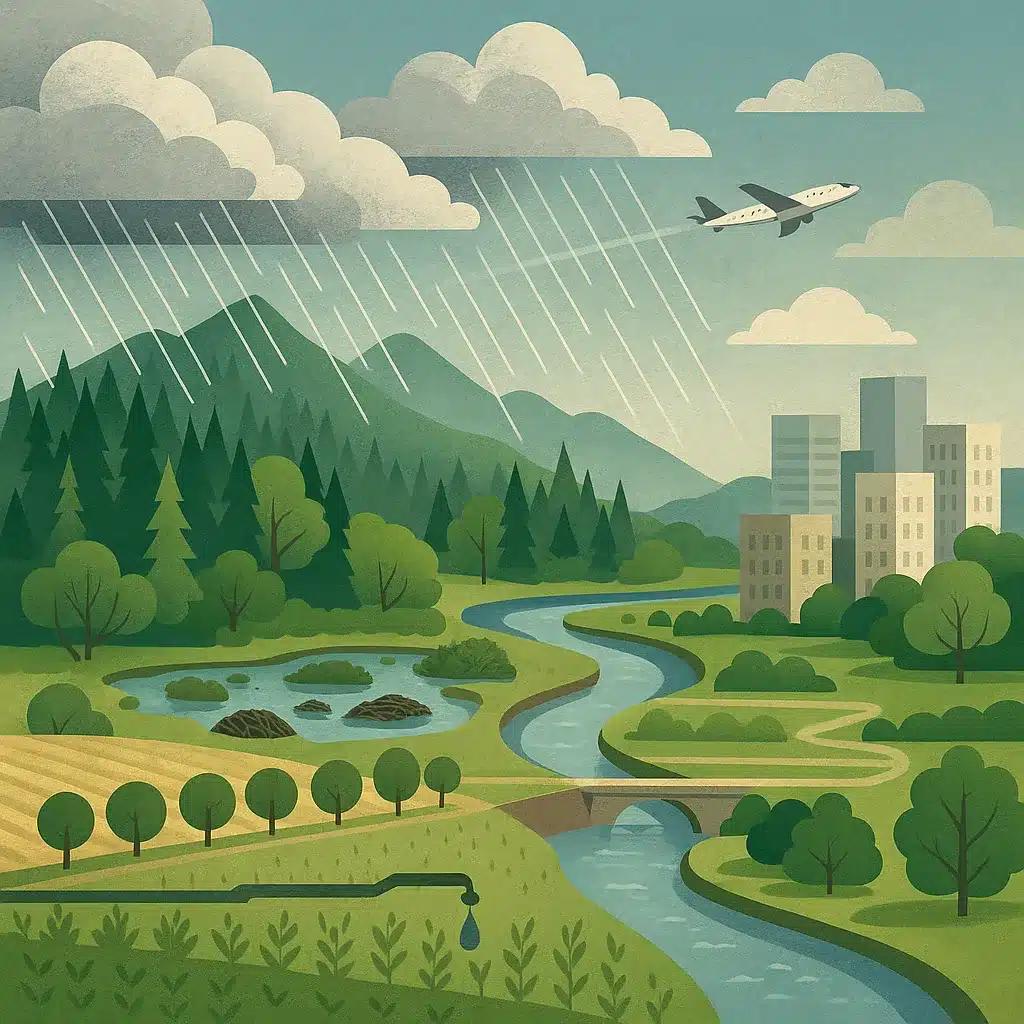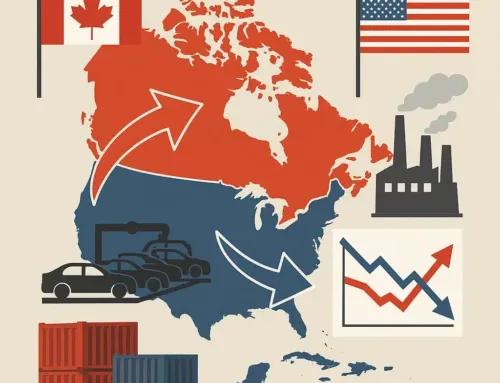
Approx. read time: 7.7 min.
Post: A powerful 25 year Climate Strategy: Rain and Resilience
Wildfires are choking cities with smoke. Heat waves are breaking records. Drought is drying landscapes to tinder. Each summer feels less like a season and more like a siege. We can cut greenhouse gases, and we must, but even if the world decarbonizes quickly, the next 25 years will be brutally hot and smoke-filled if we don’t add another tool: actively managing how water cycles through our land, skies, and communities.
That means climate resilience strategy which means finding ways to keep more moisture over land, to turn more of that moisture into rain when it’s needed, and to protect people when the skies still turn orange with smoke. It isn’t science fiction. Pieces of this toolkit already exist—forest restoration, cloud seeding, prescribed burning, cool roofs. The challenge is weaving them into a coherent, ethical strategy. Done right, these interventions could mean the difference between a livable planet and one that regularly burns humans and ecosystems alike.
Here’s how humanity could do it.
Why More Rain Matters – change in climate
Water drives climate and habitability. Forests, wetlands, and soils constantly pump moisture into the air, creating clouds and, eventually, rain. Oceans feed the bulk of atmospheric moisture, but land determines whether it falls as helpful precipitation or vanishes downwind.
When landscapes are stripped of vegetation, or when pollution and wildfire smoke fill the air, clouds often form but never release rain. Instead of cooling and cleansing, the sky traps heat and holds haze. The result is the vicious cycle we see today: hotter summers, drier soils, bigger fires, dirtier air.
Breaking this cycle requires three moves: (1) restore landscapes to hold and recycle moisture, (2) reduce the aerosols that block rainfall, and (3) carefully use precipitation enhancement when and where physics supports it.
Pillar A: Keep Moisture Over Land – a changing climate
The simplest way to “make more rain” is to stop losing the water we already have. Forests, wetlands, and healthy soils act like pumps and sponges, releasing steady streams of water vapor that feed clouds and regulating local temperatures through evaporation.
1. Restore water-makers. Mature forests, peatlands, riparian corridors, and wetlands are unmatched in their ability to keep moisture cycling. Protecting them is cheaper and more effective than any artificial technology.
2. Moisture-smart farming. Practices like agroforestry, cover crops, and no-till farming keep soils shaded and full of organic matter. That increases soil water retention, reduces surface heating, and increases evapotranspiration. Farmers who improve soil health effectively help build clouds.
3. Build sponges in the landscape. Beaver dams, wetland restoration, and small check dams re-hydrate valleys, slow down floods, and extend baseflow in rivers. These measures keep humidity higher into the dry season.
4. Strategic irrigation. When water budgets allow, irrigation can double as an atmospheric water source. Pairing irrigation with trees and shade maximizes the evaporation that actually helps create afternoon showers, rather than just runoff.
Pillar B: Cut the Things That Block Rain
Even if moisture is present, the wrong particles in the air can keep rain from falling. Smoke from wildfires and pollution from industry often create too many tiny droplets in clouds. They reflect sunlight but never merge into raindrops heavy enough to fall.
5. Prevent catastrophic wildfires. Prescribed burns, cultural burning, and forest thinning near communities reduce megafires and the weeks of smoke they produce. Less smoke means clouds more likely to rain.
6. Reduce pollution along moisture corridors. Cutting black carbon and sulfur emissions from ships, factories, and power plants has a double payoff: cleaner air for humans and healthier clouds that produce rain instead of suppressing it.
Pillar C: Enhance Precipitation—When Physics Allows
Cloud seeding has been around for decades. It works by injecting particles that help droplets grow larger in certain types of clouds. The evidence is clearest for orographic clouds—those that form as moist air rises over mountains. In those conditions, seeding with silver iodide can nudge a little more snow or rain out of the sky.
7. Cloud seeding pilots. Programs using silver iodide or hygroscopic salts should be limited to clouds that are already primed for precipitation. Randomized trials, independent monitoring, and environmental safeguards are essential. No secret spraying; no unverified claims.
8. Urban tweaks. Cities amplify heat waves through heat islands, making it harder for storms to form. Expanding tree canopy, green corridors, and cool roofs reduces this effect, sometimes making afternoon showers more likely.
Pillar D: Protect the “Flying Rivers”
Moisture doesn’t just rise and fall locally—it travels thousands of kilometers in great corridors called atmospheric rivers or “flying rivers.” Deforestation in one region can literally starve another of rain.
9. Protect upwind forests. Cities and farms must recognize that their rainfall partly depends on ecosystems hundreds of miles away. Payments for moisture services could treat forests as essential water infrastructure.
10. Design breezeways. Preserving green corridors along valleys and coastal plains keeps breezes moving inland with moisture, enhancing regional rainfall.
Pillar E: Research Bets, With Guardrails – a-changing-climate
Some ideas are still experimental. Marine cloud brightening, which sprays sea salt to reflect sunlight and maybe increase drizzle, remains too uncertain for deployment. But carefully controlled trials, with public oversight, could be justified.
11. Better models. Investing in high-resolution weather models helps identify exactly when and where interventions like cloud seeding are worth trying.
12. Biogenic cloud nuclei. Some forests release natural compounds that help clouds form. Studying how to restore those systems may reveal a safer way to enhance rainfall.
Protecting People When Rain Doesn’t Come
Even the best system won’t guarantee more rain everywhere. Smoke and heat will still strike. That means investing in resilience as much as rainfall.
13. Clean air access. Distribute N95 masks, install HEPA filters in public buildings, and create “clean rooms” for vulnerable people during smoke events.
14. Heat action plans. Expand cooling centers, enforce tree equity in cities, mandate cool roofs, and protect outdoor workers with water and rest policies. These measures save lives regardless of rainfall.
A 25-Year Timeline
Years 0–3: Laying the Foundation
-
Map where each region’s rain really comes from.
-
Build rain gauges, smoke sensors, and soil-moisture networks.
-
Launch prescribed burning brigades and urban tree-planting programs.
-
Start small, randomized cloud-seeding trials in mountain basins.
Years 3–10: Scaling Up
-
Expand wetland and riparian restoration at thousands of sites.
-
Cut black carbon and sulfur pollution regionally.
-
Roll out agroforestry belts and soil-health incentives for farmers.
-
Scale up seeding programs if trials show real results.
Years 10–25: Integration
-
Manage water, land, fire, and rainfall enhancement under one coordinated watershed-atmosphere strategy.
-
Fund forests as long-term rainfall infrastructure.
-
Build blue-green corridors through every major city.
-
Keep risky geoengineering ideas in research, not deployment, unless proven safe and effective.
Risks and Guardrails
Actively shaping rainfall carries risks. Moving more rain into one basin could reduce it elsewhere. Seeding can backfire if it increases hail or floods. Even small interventions need strict oversight.
Key safeguards include:
-
Independent evaluation of every program.
-
Public dashboards with real-time data.
-
Liability frameworks if harm occurs.
-
Equity provisions to ensure benefits aren’t hoarded by wealthy regions.
Measuring Success
It’s not just about more millimeters of rain. The metrics that matter are:
-
Rain efficiency: how much moisture becomes precipitation.
-
Timing: more wet days spread across the season, not just downpours.
-
Air quality: fewer smoke days and lower PM2.5 levels.
-
Soil moisture and stream baseflow.
-
Health outcomes: lower emergency visits during smoke and heat events.
Quick Wins Starting Today
Governments and communities could act immediately on:
-
Planting urban trees and mandating cool roofs.
-
Restoring wetlands and building beaver-analog dams.
-
Equipping schools with HEPA filters and MERV-13 HVAC.
-
Starting randomized seeding trials in snow-rich mountain regions.
-
Paying farmers for soil-health improvements that hold water.
These aren’t futuristic gambles—they’re practical steps that can be deployed tomorrow.
The Big Picture
The Earth is heating. Fires are growing. Smoke and heat are killing. Cutting carbon is non-negotiable, but it won’t be enough to keep people safe in the next quarter-century. We need a second front: managing water and air in ways that create more rain, reduce smoke, and soften extremes.
That doesn’t mean reckless geoengineering. It means respecting how land, air, and water already work together, and giving them a boost where we can. Forests, soils, wetlands, and clean air are the original rainmakers. Cloud seeding and other technologies can supplement them—but only with guardrails and transparency.
The choice is stark: either let the sky grow hotter, drier, and smokier, or actively shape a future where the water cycle works with us instead of against us. Over the next 25 years, humanity has the tools to bend the odds toward survival. Whether we use them wisely is up to us.
Related Videos:
Related Posts:
Rising from the Ashes: Why I Chose to Rebuild Myself Through Advocacy
5 Powerful Steps to Cut Off Toxic Parents While Honoring Yourself
Kingston Police’s Drone Surveillance for Distracted Driving Sparks Legal and Privacy Concerns
The Importance of Defining Roles Before Marriage: Advice I Wish My Parents Had Taught Me









